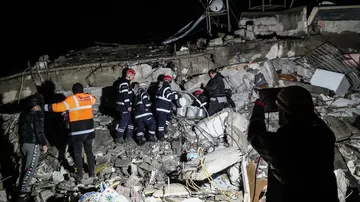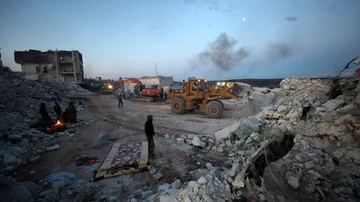Search and rescue teams from around the world have flocked to Turkey and continue to do so to deal with the catastrophic consequences of the earthquakes that struck Turkey and Syria on Monday, killing thousands and injuring thousands in the last days. In both territories, the multiple international rescue devices work around the clock to try to save the citizens who still survive under the rubble. Also at night, with great complications.
They use spotlights and flashlights, and all kinds of protection against the cold -every night temperatures are close to zero or below-, to remove rubble, looking for the last survivors; everything that can humanly be done more than 70 hours after the initial earthquake. Despite the desolation, there is still hope. So far, 8,000 people affected by the earthquakes have been rescued. Without going any further, the rescue teams of Turkey have managed to rescue six people, including three children, under the rubble of a destroyed building in the city of Kirijan at dawn. An action that was carried out after hearing sounds under the rubble during the day.

The Turkish National Medical Rescue Team worked all day to remove them to finally find the whereabouts of these six victims, who were rescued with shouts of joy. Hours earlier, Turkish emergency services managed to pull Saziye Kalaagzi, an 80-year-old woman from the rubble who was under a destroyed five-story building in the city of Eroglu, just ten kilometers from the Syrian border. But Turkish devices are not alone. The Disaster and Emergency Management Authority in Turkey has indicated that nearly 100,000 search and rescue team members, including international groups and NGOs, are working in the affected areas. Proof of this is the new miracle carried out by Spanish rescuers.
Specifically, by the firefighters and volunteers from the UREC of the Valencia Provincial Firefighters Consortium and the Valencian NGO Intervention, Aid and Emergencies (IAE), which this morning They have rescued a 12-year-old girl and her father from the rubble of a building in Turkey.The rescue has lasted for six intense hours, due to the devastation of the situation. Other Spanish firefighters transferred to Elbistan, a city of about 150,000 inhabitants also affected by the earthquakes, have not been so lucky. Although they have not stopped working since they arrived – “nothing more than a couple of hours to rest”, they say – they have not been as lucky as in other areas. Especially, due to the great inconvenience caused by temperatures at ten degrees below zero: “In principle, no living person could be located, but we continue working until Thursday night, since we have to return to Spain on Friday.”
Syria waiting for help
The neighbors themselves, between the shock of what happened and the panic for the future, also collaborate with the troops. Because there, in the affected areas of Turkey, no one sleeps at home since monday. Everyone is in the streets, in open fields, with bonfires, warming up because there are temperatures close to zero. The neighbors endure as it is, in stores, in cars. Others have left or, at least, are trying to, causing huge traffic jams on the streets and highways, which are also in a state of disrepair from the earthquake. A very different situation from the one that, unfortunately, is taking place in Syriaalready considered the second country most affected by the chaos caused by the earthquakes.
There, families wait around makeshift bonfires next to buildings destroyed by earthquakes, waiting for rescue teams to find their loved ones missing in the tragedy. Two and a half days after the first earthquake, hopes of finding survivors are fading, but there are many who still stand up to the icy cold of winter as they can to be the first to know the news, good or bad, that keeps emerging from the rubble. In Melkis, and other opposition areas in the provinces of Idlib and Aleppo hard hit by the catastrophe, search operations continue with the participation of residents and rescuers from the so-called White Helmets, who estimate that “hundreds” of people they remain buried.

In other places like the town of Harem, in Idlib, the work is being led by residents, volunteers and combatants of the local armed groups, with a small presence of members of the White Helmets, the first aid workers in the Syrian areas in the hands of the opposition. Also in Syria, the earthquakes have left tens of thousands of families homeless, who for three nights have been surviving the low temperatures in cars, out in the open or, more recently, in a series of shelters opened by the authorities to accommodate the victims. All while the balance of fatalities and injuries continues to grow, practically every minute, which already number in the thousands in both cases.
Source: Lasexta
Ricardo is a renowned author and journalist, known for his exceptional writing on top-news stories. He currently works as a writer at the 247 News Agency, where he is known for his ability to deliver breaking news and insightful analysis on the most pressing issues of the day.












